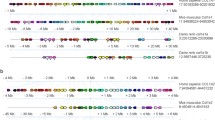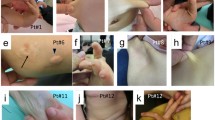Abstract
Decorin, a prototype member of the growing family of the small leucine-rich proteoglycans (SLRP's), plays significant roles in tissue development and assembly, as well as playing both direct and indirect signaling roles. This review will concentrate on decorin's function in collagen fibrillogenesis as determined through the study of mice with a disrupted decorin gene. The fragile skin and abnormal tendon phenotypes initially observed were found to be due to fundamental alterations in collagen fibers, highlighting the crucial role of proteoglycans in general and SLRP's in particular in collagen fibrillogenesis. The altered fibril formation within tissues in turn leads to observable and quantifiable changes at the organismal level. Research into certain fibrotic processes with concomitant upregulation or reduction of decorin makes interesting comparisons with the collagen malformations seen in Dcn −/− mice. Overall, decorin is shown to be a vital player in maintaining skin and tendon integrity at the molecular level, among other functions. Published in 2003.
Similar content being viewed by others
References
Danielson KG, Baribault H, Holmes DF, Graham H, Kadler KE, Iozzo RV, Targeted disruption of decorin leads to abnormal collagen fibril morphology and skin fragility, J Cell Biol 136, 729–43 (1997).
Iozzo RV, The biology of the small leucine-rich proteoglycans. Functional network of interactive proteins, J Biol Chem 274, 18843–6 (1999).
Iozzo RV, Matrix proteoglycans: From molecular design to cellular function, Annu Rev Biochem 67, 609–52 (1998).
Hocking AM, Shinomura T, McQuillan DJ, Leucine-rich repeat glycoproteins of the extracellular matrix, Matrix Biol 17, 1–19 (1998).
Scott JE, Proteoglycan-fibrillar collagen interactions, Biochem J 252, 313–23 (1988).
Iozzo RV, Murdoch AD, Proteoglycans of the extracellular environment: Clues from the gene and protein side offer novel perspectives in molecular diversity and function, FASEB J 10, 598–614 (1996).
Iozzo RV, The family of the small leucine-rich proteoglycans: Key regulators of matrix assembly and cellular growth, Crit Rev Biochem Mol Biol 32, 141–74 (1997).
Kresse H, Schönherr E, Proteoglycans of the extracellular matrix and growth control, J Cell Physiol 189, 266–74 (2001).
Ramamurthy P, Hocking AM, McQuillan DJ, Recombinant decorin glycoforms. Purification and structure, J Biol Chem 271, 19578–84 (1996).
Kobe B, Kajava AV, The leucine-rich repeat as a protein recognition motif, Curr Opin Struct Biol 11, 725–32 (2001).
Weber IT, Harrison RW, Iozzo RV, Model structure of decorin and implications for collagen fibrillogenesis, J Biol Chem 271, 31767–70 (1996).
Keene DR, San Antonio JD, Mayne R, McQuillan DJ, Sarris G, Santoro SA, Iozzo RV, Decorin binds near the C terminus of type I collagen, J Biol Chem 275, 21801–4 (2000).
Scott JE, Proteodermatan and proteokeratan sulfate (decorin, lumican/ fibromodulin) proteins are horseshoe shaped. Implications for their interactions with collagen, Biochemistry 35, 8795–9 (1996).
Spiro RC, Countaway JL, Gaarde WA, Garcia JA, Leisten J, O'Neill JJ, Smiley WR, Stecker K, Harper JR, Analysis of collagen-binding properties of human recombinant decorin, Mol Biol Cell 55, 303a (1994).
Schönherr E, Hausser H, Beavan L, Kresse H, Decorin-type I collagen interaction. Presence of separate core protein-binding domains, J Biol Chem 270, 8877–83 (1995).
Svensson L, Heinegård D, Oldberg Å, Decorin binding sites for collagen type I are mainly located in leucine rich repeats 4-5, J Biol Chem 270, 20712–6 (1995).
Kresse H, Liszio C, Schönherr E, Fisher LW, Critical role of glutamate in a central leucine-rich repeat of decorin for interaction with type I collagen, J Biol Chem 272, 18404–10 (1997).
Yu L, Cummings C, Sheehan JK, Kadler KE, Holmes DF, Chapman JA, Visualisation of individual proteoglycan-collagen interactions. In Dermatan Sulphate Proteoglycans, edited by Scott JE (London: Portland Press, 1993), pp. 183–92.
Santra M, Reed CC, Iozzo RV, Decorin binds to a narrow region of the EGF receptor, partially overlapping witrh, but distinct from, the EGF-binding epitope, J Biol Chem 277, 35671–81 (2002).
Scott JE, Orford CR, Dermatan sulphate-rich proteoglycan associates with rat tail-tendon collagen at the d band in the gap region, Biochem J 197, 213–6 (1981).
Vogel KG, Paulsson M, Heinegård D, Specific inhibition of type I and type II collagen fibrillogenesis by the small proteoglycan of tendon, Biochem J 223, 587–97 (1984).
Thieszen SL, Rosenquist TH, Expression of collagens and decorin during aortic arch artery development: Implications for matrix pattern formation, Matrix Biol 14, 573–82 (1994).
Bidanset DJ, Guidry C, Rosenberg LC, Choi HU, Timpl R, Höök M, Binding of the proteoglycan decorin to collagen type VI, J Biol Chem 267, 5250–6 (1992).
Yamaguchi Y, Mann DM, Ruoslahti E, Negative regulation of transforming growth factor-β by the proteoglycan decorin, Nature 346, 281–4 (1990).
Hildebrand A, Romaris M, Rasmussen LM, Heinegård D, Twardzik DR, Border WA, Ruoslahti E, Interaction of the small interstitial proteoglycans biglycan, decorin and fibromodulin with transforming growth factor-β, Biochem J 302, 527–34 (1994).
Yamaguchi Y, Ruoslahti E, Expression of human proteoglycan in Chinese hamster ovary cells inhibits cell proliferation, Nature 336, 244–6 (1988).
De Luca A, Santra M, Baldi A, Giordano A, Iozzo RV, Decorininduced growth suppression is associated with upregulation of p21, an inhibitor of cyclin-dependent kinases, J Biol Chem 271, 18961–5 (1996).
Santra M, Mann DM, Mercer EW, Skorski T, Calabretta B, Iozzo RV, Ectopic expression of decorin protein core causes a generalized growth suppression in neoplastic cells of various histogenetic origin and requires endogenous p21, an inhibitor of cyclin-dependent kinases, J Clin Invest 100, 149–57 (1997).
Santra M, Eichstetter I, Iozzo RV, An anti-oncogenic role for decorin: Downregulation of ErbB2 leads to growth suppression and cytodifferentiation of mammary carcinoma cells, J Biol Chem 275, 35153–61 (2000).
Nash MA, Loercher AE, Freedman RS, In vitro growth inhibition of ovarian cancer cells by decorin: Synergism of action between decorin and carboplatin, Cancer Res 59, 6192–6 (1999).
Grant DS, Yenisey C, Rose RW, Tootell M, Santra M, Iozzo RV, Decorin suppresses tumor cell-mediated angiogenesis, Oncogene 21, 4765–77 (2002).
Reed CC, Gauldie J, Iozzo RV, Suppression of tumorigenicity by adenovirus-mediated gene transfer of decorin, Oncogene 21, 3688–95 (2002).
Schönherr E, Broszat M, Brandan E, Bruckner P, Kresse H, Decorin core protein fragment Leu 155-Val260 interacts with TGF-β but does not compete for decorin binding to type I collagen, Arch Biochem Biophys 35, 241–8 (1998).
Schönherr E, O'Connell BC, Schittny J, Robenek H, Fastermann D, Fisher LW, Plenz G, Vischer P, Young MF, Kresse H, Paracrine or virus-mediated induction of decorin expression by endothelial cells contributes to tube formation and prevention of apoptosis in collagen lattices, Eur J Cell Biol 78, 44–55 (1999).
Xaus J, Comalada M, Cardó M, Valledor AF, Celada A, Decorin inhibits macrophage colony-stimulating factor proliferation of macrophages and enhances cell survival through induction of p27Kip1 and p21Waf1, Blood 98, 2124–33 (2001).
Fischer JW, Kinsella MG, Levkau B, Clowes AW, Wight TN, Retroviral overexpression of decorin differentially affects the response of arterial smooth muscle cells to growth factors, Arterioscler Thromb Vasc Biol 21, 777–84 (2001).
Graham HK, Holmes DF, Watson RB, Kadler KE, Identification of collagen fibril fusion during vertebrate tendon morphogenesis. The process relies on unipolar fibrils and is regulated by collagenproteoglycan interaction, Journal of Molecular Biology 295, 891–902 (2000).
Melis P, Noorlander ML, van der Horst CM, van Noorden CJ, Rapid alignment of collagen fibers in the dermis of undermined and not undermined skin stretched with a skin-stretching device, Plastic & Reconstructive Surgery 109, 674–82 (2002).
Xu T, Bianco P, Fisher LW, Longenecker G, Smith E, Goldstein S, Bonadio J, Boskey A, Heegaard A-M, Sommer B, Satomura K, Dominguez P, Zhao C, Kulkarni AB, Robey PG, Young MF, Targeted disruption of the biglycan gene leads to an osteoporosislike phenotype in mice, Nature Genet 20, 78–82 (1998).
Corsi A, Xu T, Chen X-D, Boyde A, Liang J, Mankani M, Sommer B, Iozzo RV, Eichstetter I, Robey PG, Bianco P, Young MF, Phenotypic effects of biglycan deficiency are linked to collagen fibril abnormalities, are synergized by decorin deficiency, and mimic ehlers-danlos-like changes in bone and other connective tissues, J Bone Min Res 17, 1180–9 (2002).
Hunzelmann N, Anders S, Sollberg S, Schönherr E, Krieg T, Co-ordinate induction of collagen type I and biglycan expression in keloids, Brit J Dermatol 135, 394–9 (1996).
Chakravarti S, Magnuson T, Lass JH, Jepsen KJ, LaMantia C, Carroll H, Lumican regulates collagen fibril assembly: Skin fragility and corneal opacity in the absence of lumican, J Cell Biol 141, 1277–86 (1998).
Cribb AM, Scott JE, Tendon response to tensile stress: An ultrastructural investigation of collagen:proteoglycan interactions in stressed tendon, J Anat 187, 423–8 (1995).
Fukui N, Fukuda A, Kojima K, Nakajima K, Oda H, Nakamura K, Suppression of fibrous adhesion by proteoglycan decorin, J Ortho Res 19, 456–62 (2001).
Isaka Y, Brees DK, Ikegaya K, Kaneda Y, Imai E, Noble NA, Border WA, Gene therapy by skeletal muscle expression of decorin prevents fibrotic disease in rat kidney, Nature Med 2, 418–23 (1996).
Kolb M, Margetts PJ, Galt T, Sime PJ, Xing Z, Schmidt M, Gauldie J, Transient transgene expression of decorin in the lung reduces the fibrotic response to bleomycin, Am J Respir Crit Care Med 163, 770–7 (2001).
Nakamura N, Hart DA, Boorman RS, Kaneda Y, Shrive NG, Marchuk LL, Shino K, Ochi T, Frank CB, Decorin antisense gene therapy improves functional healing of early rabbit ligament scar with enhanced collagen fibrillogenesis in vivo, J Ortho Res 18, 517–23 (2000).
Kuc IM, Scott PG, Increased diameters of collagen fibrils precipitated in vitro in the presence of decorin from various connective tissues, Connective Tissue Research 36, 287–96 (1997).
Vogel KG, Trotter JA, The effects of proteoglycans on the morphology of collagen fibrils formed in vitro, Collagen Rel Res 7, 105–14 (1987).
Larjava H, Häkkinen L, Rahemetulla F, A biochemical analysis of periodontal tissue proteoglycans, Biochem J 284, 267–74 (1992).
Cheng H, Caterson B, Yamauchi M, I. Identification and immunolocalization of chondroitin sulfate proteoglycans in tooth cementum, Connective Tissue Res 40, 37–47 (1999).
Oksala O, Haapasalmi K, Häkkinen L, Uitto VJ, Larjava H, Expression of heparan sulphate and small dermatan/chondroitin sulphate proteoglycans in chronically inflamed human periodontium, J Dent Res 76, 1250–9 (1997).
Robey PG, Vertebrate mineralized matrix proteins: Structure and function, Connective Tissue Res 35, 131–6 (1996).
Oksala O, Salo T, Tammi R, Häkkinen L, Jalkanen M, Inki P, Larjava H, Expression of proteoglycans and hyaluronan during wound healing, J Histochem Cytochem 43, 125–35 (1995).
Häkkinen L, Oksala O, Salo T, Rahemtulla F, Larjava H, Immunohistochemical localization of proteoglycans in human periodontium, J Histochem Cytochem 41, 1689–99 (1993).
Hakkinen L, Strassburger S, Kahari VM, Scott PG, Eichstetter I, Lozzo RV, Larjava H, A role for decorin in the structural organization of periodontal ligament, Lab Invest 80, 1869–80 (2000).
Schaefer L, Macakova K, Raslik I, Micegova M, Gröne H-J, Schönherr E, Robenek H, Echtermeyer FG, Grässel S, Bruckner P, Schaefer RM, Iozzo RV, Kresse H, Absence of decorin adversely influences tubulointerstitial fibrosis of the obstructed kidney by enhanced apoptosis and increased inflammatory reaction, Am J Pathol 160, 1181–91 (2002).
Iozzo RV, Chakrani F, Perrotti D, McQuillan DJ, Skorski T, Calabretta B, Eichstetter I, Cooperative action of germline mutations in decorin and p53 accelerates lymphoma tumorigenesis, Proc Natl Acad Sci USA 96, 3092–7 (1999).
Brown EL, Wooten RM, Johnson BJ, Iozzo RV, Smith A, Dolan MC, Guo BP, Weis JJ, Höök M, Resistance to Lyme disease in decorin-deficient mice, J Clin Invest 107, 845–52 (2001).
Guo B, Norris S, Rosenberg LC, Höök M, Adherence of Borrelia burgdorferi to the proteoglycan decorin, Infect Immun 63, 3467–72 (1995).
Author information
Authors and Affiliations
Corresponding author
Rights and permissions
About this article
Cite this article
Reed, C.C., Iozzo, R.V. The role of decorin in collagen fibrillogenesis and skin homeostasis. Glycoconj J 19, 249–255 (2002). https://doi.org/10.1023/A:1025383913444
Issue Date:
DOI: https://doi.org/10.1023/A:1025383913444




